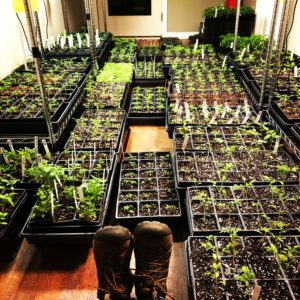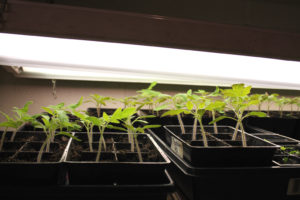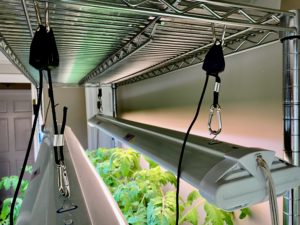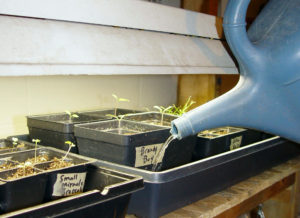Joe’s Seed-Starting Tips
March 17th, 2020
Joe Lamp’l, a.k.a. “Joe Gardener” and the host of PBS’s “Growing a Greener World,” is one America’s most trusted garden communicators because he’s such a practical guy who draws on what he’s learned from his own lifetime of hands-on gardening.
Joe’s latest and maybe most prodigious effort yet is his attempt to figure out the best way that home gardeners can start their own plants from seeds.
Seed-starting can be tricky if you don’t know some of the key “secrets.” It doesn’t help that much of the advice is a bit murky and sometimes conflicting.
So Joe set out to see what really works by turning a 10-by-25-foot basement room at his Atlanta-area home into a seed-starting lab, crammed with 60 seed trays that had anywhere from 18 to 72 cells each.
He bought all sorts of lights and grew the seedlings under 14 different lighting scenarios to see what difference that important factor makes.
His findings are the genesis of a new $197 Master Seed-Starting course he’s offering through his Organic Gardening Academy.
But Joe shared some of his seedy findings in an interview with Margaret Roach, the former editorial director for Martha Stewart’s magazines. The whole interview is on Roach’s “A Way to Garden” website, if you want to read or hear it.
When it comes to lighting, Joe says ordinary workshop fluorescent light tubes (known as T12s) work reasonably well if you’re just growing seedlings for six weeks. One cool-light tube and one warm one in each unit improve the light spectrum.
Joe says the higher-efficiency T5 fluorescent tubes and newer LED grow lights are markedly brighter. However, he found that biggest and brightest doesn’t always equate to best plant performance.
“Just because a light is brighter doesn’t necessarily make it better,” he concluded.
How you use a light is also very important.
Joe says if you’re going to use the cheapo workshop lights, you have to keep the lights very close above the seedlings. He recommends about one inch.
Joe found that high-output T5 fluorescent tubes are much brighter but also put out more heat, which means they can’t go as close without frying the tips of the tender seedlings.
“My sweet spot above the tops of the plants on my T5s was about six inches above the top of the foliage,” Joe says.
LED height varies with their intensity and heat output. Joe says you can buy a $150 light meter to get exact readings, or you can just “use your eyes and look at how the plants respond. They’ll really give you lots of clues. You might not be able to detect the brightness of that light, but your plants will tell you.”
The best example he found was the honking big, 2,000-watt, full-spectrum, $300 grow-light LED bulb that he bought for the experiment.
“It was 48 inches long and 20 inches wide,” he says. “It covered the whole shelf.”
However, that light turned out to be too much for the little seedlings.
“The instructions that came with it said, ‘Start off with the lights 24 inches above the plants,” says Joe. “So I did that and initially got picture-perfect seedlings. But the longer those seedlings were under those lights, the more they showed they were uncomfortable.
“They weren’t filling out. It’s almost like they didn’t want to grow anymore. So I raised the lights up and the plants responded favorably. But as they got taller, they again kind of shut down. And then they showed other symptoms that told me the light was too bright. The bottom line was that I just couldn’t get the plants far enough away from the light.”
He concluded that big lights like that one were best suited for growing larger plants, especially ones you’re trying to get to flower and fruit inside.
To regulate the height, Joe says ratchet pulleys are a better idea than hanging chains from S hooks.
With the pulleys, you tug on the thin cord to click the lights up and down, making it easier to raise, lower, and level without worry of the S hooks falling out and the lights crashing down on the seed trays.
As for how long the lights should run, Joe says 16 hours on and eight hours off is usually ideal.
“That’s a good rule of thumb,” he says, “but again, it depends on how much light is getting to your plants over a 24-hour period. What I did find was that when I left the lights on for 24 hours a day with a reasonably bright light, it was more light than the plant wanted.”
Joe says in that scenario, plants didn’t grow as vigorously as ones that got an eight-hour “rest” in darkness.
On when to start seeds, Joe says you don’t want to start them too early and have them grow too long inside.
“The longer they’re in that artificial environment before you can plant them outside, the more stressed they become,” Joe says. “They’re not getting what they need as they get bigger… Try to resist the urge to start too early. What I concluded was that it’s better to start a little bit later than a little bit earlier.”
With watering, Joe said he found that it’s better to add water to the seed tray and let the roots soak it up than to douse the tender seedlings with watering cans from above.
For one thing, he says it’s difficult to top-water under fluorescent lights since they’re so close to the tops of the foliage.
“Plus you’re beating those little seedlings down when the water droplets hit it,” he says. “But the problem with bottom-watering is that there is a level of water in that bottom tray. Then you have a portion of your root mass or your soil sitting in that water, too. Some of those roots can be under water and drowning.”
A way to solve that is to limit the water to what the seedling mix soaks up in about 15 minutes or to dump any excess water after the surface of the seedling mix becomes wet (my advice here).
Joe says germination mats and those plastic domes are fine for germinating seeds, but once plants are up and growing, both are best removed.
He says heat mats “speed up the germination time by anywhere from a day to several days because plants have an ideal germination range.”
After that, seedlings grow stockier in cooler temperatures. I’ve found the 55- to 60-degree range is excellent.
Plastic domes help hold in heat and moisture to aid germination, too, but Joe says he removes them once seeds are up “because if you don’t, you trap too much humidity around the base of the plant. Then they’re subjected to a fungal disease called damping off. That’s the No. 1 killer with young seedlings and it comes from too much moisture around the base of the plant.”
Joe recommends running a small fan or two on low across the seedlings.
“If you can keep air moving across the base of the soil, right where those seedlings are, you greatly reduce the risk that you’re going to have any sort of fungal disease,” he says. “Plus air circulation, period, is good to have around plants and so it doesn’t hurt to have those fans there. I highly recommend it. I put those on the must-haves list of things that you need when you start your seeds.”
For the inexpensive system I’ve used to start seeds in a dark basement over the last three decades, check out the illustrated post I wrote for PennLive.com called “How to Start Your Garden Indoors on the Cheap.”











